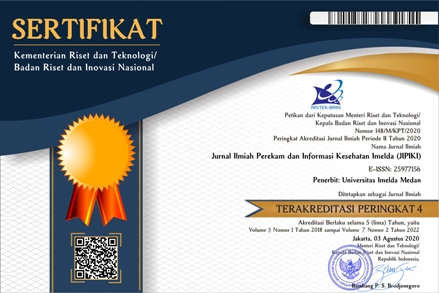Rekam Medis Elektronik sebagai Pendukung Manajemen Pelayanan Pasien di RS Universitas Gadjah Mada
DOI:
https://doi.org/10.52943/jipiki.v7i1.599Keywords:
Electronic Medical Record, Electronic Health Record, Case Management, BenefitsAbstract
Electronic Medical Records (EMR) is a digital repository of administrative and medical data to support integrated health services. EMR can be used to support case management activities such as identification, care coordination, patient progress monitoring, and provide cost-effective interventions. One of main factor in information system implementation is users. Based on users’ perceptions, recommendations can be made. It’s used to maximize the adoption and development of EMR. The purpose of this study to explore the users’ perceived benefits of EMR implementation to support case management. This research is a qualitative research with a case study design. Informants were EMR users, namely doctors, nurse, pharmacist, medical record officer, and laboratory assistant. They were selected through purposive sampling technique. We conducted face-to-face semi-structured interviews and observation. This research used an interview guide with open-ended questions and an observation guide. Results showed benefits of EMR were support patient safety, reduce duplicate examinations, continuity of care, patient care efficiency, and collaboration among health professionals. It is suggested to develop a patient reminder feature and periodic staff training.
Downloads
References
[2] P. Campanella et al., “The Impact of Electronic Health Records on Healthcare Quality: A Systematic Review and Meta-Analysis,” Eur. J. Public Health, vol. 26, no. 1, pp. 60–64, 2016, doi: 10.1093/eurpub/ckv122.
[3] Case Management Society of America, Standards of Practice for Case Management. 2016.
[4] J. D. Hatton, T. M. Schmidt, and J. Jelen, “Adoption of Electronic Health Care Records?: Physician Heuristics and Hesitancy,” vol. 5, pp. 706–715, 2012, doi: 10.1016/j.protcy.2012.09.078.
[5] N. Shaw, “The Role Of The Professional Association: A Grounded Theory Study of Electronic Medical Records Usage in Ontario, Canada,” Int. J. Inf. Manage., vol. 34, no. 2, pp. 200–209, 2014, doi: 10.1016/j.ijinfomgt.2013.12.007.
[6] J. W. Creswell, Research Design?: Qualitative, Quantitative, and Mixed Method Approach. London: Sage Publications, Inc, 2014.
[7] M. Khalifa, “Barriers to Health Information Systems and Electronic Medical Records Implementation A Field Study of Saudi Arabian Hospitals,” Procedia - Procedia Comput. Sci., vol. 21, pp. 335–342, 2013, doi: 10.1016/j.procs.2013.09.044.
[8] M. Cucciniello, I. Lapsley, G. Nasi, and C. Pagliari, “Understanding Key Factors Affecting Electronic Medical Record Implementation: A Sociotechnical Approach,” BMC Health Serv. Res., vol. 15, no. 1, pp. 1–19, 2015, doi: 10.1186/s12913-015-0928-7.
[9] W. Youssef, “Evaluation Of EHR Training as a Catalyst to Achieve Clinician Satisfaction with Technology in Acute Care Setting,” ProQuest Diss. Theses, p. 161, 2013, [Online]. Available: http://search.proquest.com/docview/1520432451?accountid=458.
[10] É. Maillet, L. Mathieu, and C. Sicotte, “Modeling Factors Explaining the Acceptance, Actual Use, and Satisfaction of Nurses Using An Electronic Patient Record in Acute Care Settings?: An Extension of the UTAUT,” Int. J. Med. Inform., vol. 84, no. 1, pp. 36–47, 2014, doi: 10.1016/j.ijmedinf.2014.09.004.
[11] W. S. Margareta and D. Iwan, “Peran Resep Elektronik dalam Meningkatkan Medication Safety pada Proses Peresepan,” J. Manaj. Pelayanan Kesehat., vol. 17, no. 1, pp. 30–36, 2014.
[12] R. Shawahna, N. U. Rahman, M. Ahmad, M. Debray, M. Yliperttula, and X. Declèves, “Electronic Prescribing Reduces Prescribing Error In Public Hospitals,” J. Clin. Nurs., vol. 20, no. 21–22, pp. 3233–3245, 2011, doi: 10.1111/j.1365-2702.2011.03714.x.
[13] E. E. Roughead, A. I. Vitry, G. E. Caughey, and A. L. Gilbert, “Multimorbidity, Care Complexity, and Prescribing for The Elderly,” Aging health, vol. 7, no. 5, pp. 695–705, 2011, doi: 10.2217/ahe.11.64.
[14] P. Jia, L. Zhang, J. Chen, P. Zhao, and M. Zhang, “The Effects of Clinical Decision Support Systems on Medication Safety?: An Overview,” pp. 1–17, 2016, doi: 10.1371/journal.pone.0167683.
[15] N. Tavakoli, M. Jahanbakhsh, H. Mokhtari, and H. R. Tadayon, “Opportunities of Electronic Health Record Implementation in Isfahan,” Procedia Comput. Sci., vol. 3, pp. 1195–1198, 2011, doi: 10.1016/j.procs.2010.12.193.
[16] A. S. Kazley, A. N. Simpson, K. N. Simpson, and R. Teufel, “Association of Electronic Health Records With Cost Savings in a National Sample,” vol. 20, no. 6, pp. 183–190, 2014.
[17] S. Silow-Carroll, J. N. Edwards, and D. Rodin, “Using Electronic Health Records to Improve Quality and Efficiency: The Experiences of Leading Hospitals,” Commonw. Fund, vol. 17, pp. 1–40, 2012.
[18] Y. H. Sidek and J. T. Martins, “Perceived Critical Success Factors of Electronic Health Record System Implementation In A Dental Clinic Context: An Organisational Management Perspective,” Int. J. Med. Inform., vol. 107, pp. 88–100, 2017, doi: 10.1016/j.ijmedinf.2017.08.007.
[19] J. Haskew, G. Rø, K. Turner, D. Kimanga, M. Sirengo, and S. Sharif, “Implementation of A Cloud-Based Electronic Medical Record to Reduce Gaps in The HIV Treatment Continuum In Rural Kenya,” PLoS One, vol. 10, no. 8, pp. 1–10, 2015, doi: 10.1371/journal.pone.0135361.
[20] A. De Benedictis, E. Lettieri, L. Gastaldi, C. Masella, A. Urgu, and D. Tartaglini, “Electronic Medical Records Implementation In Hospital: An Empirical Investigation Of Individual And Organizational Determinants,” PLoS One, vol. 15, no. 6, pp. 1–12, 2020, doi: 10.1371/journal.pone.0234108.
[21] A. Singer and R. D. Fernandez, “The Effect of Electronic Medical Record System Use on Communication Between Pharmacists and Prescribers,” BMC Fam. Pract., vol. 16, no. 1, pp. 1–6, 2015, doi: 10.1186/s12875-015-0378-7.
[22] F. Lau, M. Price, J. Boyd, C. Partridge, H. Bell, and R. Raworth, “Impact of Electronic Medical Record on Physician Practice in Office Settings: A Systematic Review,” BMC Med. Inform. Decis. Mak., vol. 12, no. 1, 2012, doi: 10.1186/1472-6947-12-10.
[23] M.-M. Bouamrane and F. S. Mair, “A Study Of General Practitioners’ Perspectives on Electronic Medical Records Systems In Nhsscotland,” BMC Med. Inform. Decis. Mak., vol. 13, p. 58, 2013, doi: 10.1186/1472-6947-13-58.
[24] F. Erawantini, E. Nugroho, G. Y. Sanjaya, and S. Hariyanto, “Rekam Medis Elektronik: Telaah Manfaat Dalam Konteks Pelayanan Kesehatan Dasar,” in Prosiding Forum Informatika Kesehatan Indonesia, 2013, vol. 1, no. 1, pp. 1–10.
[25] T. S. Loo et al., “Electronic Medical Record Reminders and Panel Management to Improve Primary Care of Elderly Patients,” Am. Med. Assoc., vol. 171, no. 17, pp. 1552–1558, 2011.











